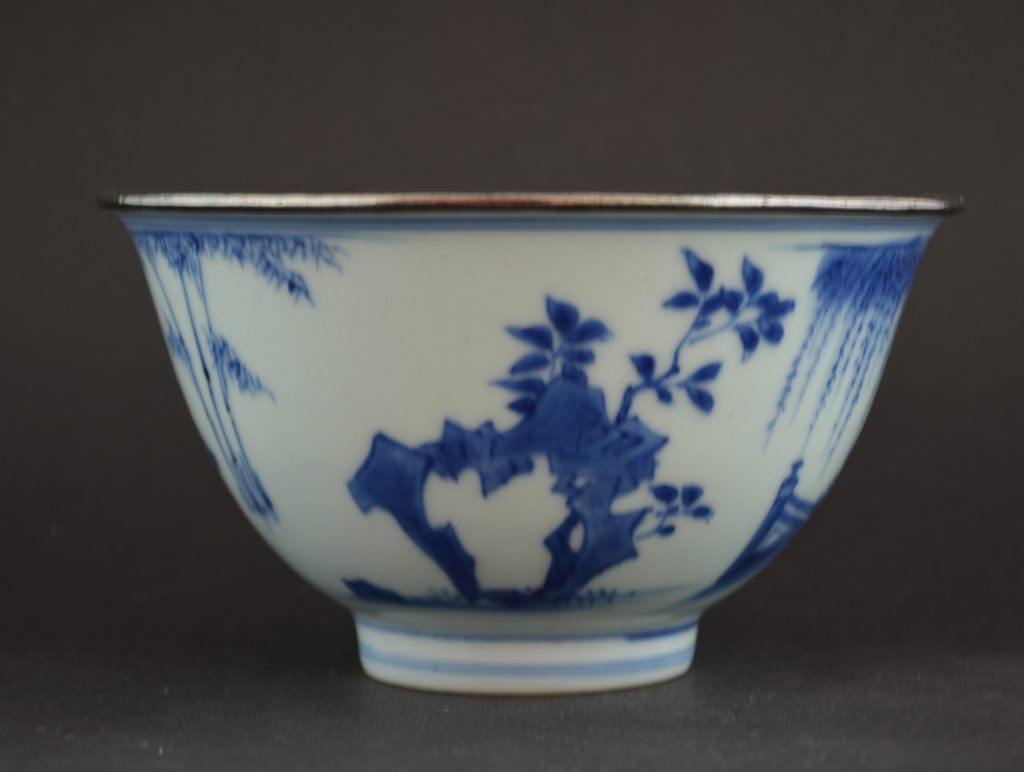
SHUNZHI 1644 – 1661 Transitional Porcelain
A Transitional Blue and White Porcelain Bowl, Shunzhi c.1650-1660. Decorated with Elegant Ladies Under a Willow Tree in a Garden Landscape. The Continuous Scene Includes a Table Between Bamboo and a Scholars Rock.
SOLD
- Condition
- The very thin silver rim might has minute chips beneath it or it might just be decorative.
- Size
- Diameter : 14 cm (5.5 inches)
- Provenance
- Sotheby`s, 18th of April 1978, lot 132. The Fiorentini Collection, label to base. (the collection acquired c.1945-1990).
- Stock number
- 24405
Information
Apocryphal Marks :
Apocryphal marks are frequently encountered on Chinese porcelain, particularly on Kangxi Blue and White Porcelain but also on Transitional porcelain like the present example. The mark of the Ming Emperor Chenghua who reigned from 1465 to 1487 being by far the most common, other Ming marks include Jiajing (1522-1566) and less frequently Wanli (1573-1620). These marks were not added to the piece to deceive, but more as a sign of reverence to earlier potters of the Ming dynasty (1368-1644). Occasionally they are used on pieces copying Ming Porcelain, these objects were probably made for collectors who could not afford the Ming original. Tianqi is an early period for such an apocryphal mark.
Shunzhi 1644-1661 :
The Shunzhi emperor (lived 1638 to 1661) was the second emperor of the Manchu Qing dynasty, and the first Qing emperor to rule over China proper. He ascended to the throne aged five (six sui according to traditional Chinese count) in 1643 upon the death of his father, Hong Taiji, but actual power during the early part of his reign lay in the hands of the appointed regents, Princes Dorgon and Jirgalang. With the Qing pacification of the former Ming provinces almost complete, he died still a young man, although in circumstances that have lent themselves to rumour and speculation. In the midst of much upheaval, the Manchus seized control of Beijing in June 1644, and in October of the same year the Shunzhi emperor`s uncle, the chief regent Prince, proclaimed the Qing dynasty to be the legitimate successor to the Ming dynasty. Therefore, although the Shunzhi emperor was not the founder of the Qing dynasty, he was the first Qing emperor of China. His mother was Empress Dowager Xiao Zhuang Wen who was an excellent politician during the period. The young emperor disliked his uncle, the chief regent Prince Dorgon, and after Dorgon`s death in 1650 the emperor stripped both him and Dorgon`s brother, Prince Dodo, of their titles, although he was only 12 years old at the time. During his short reign, the Shunzhi emperor encouraged the Han Chinese to participate in government activities. He was a scholar and employed Han Chinese to teach his children. The emperor married his mother`s niece, but demoted the empress several years later. Four months after his favourite concubine passed away, he died of smallpox. Before he passed away, he appointed four regents to help his son, Hiowan Yei. They were Oboi, Sonin, Suksaha and Ebilun. It was believed that the young emperor did not pass away but left the palace to become a monk.







